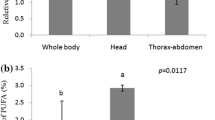Summary
Repeated stimulation ofHydra magnipapillata with the diacylglycerol (DG) 1,2-sn-dioctanoylglycerol (diC8) induces an increase in positional value and eventually the development of ectopic heads. Upon stimulation, the polyps release [14C]-arachidonic acid from previously labelled endogenous sources. Arachidonic acid (AA) is not released into the external medium but remains within the animal, AA, linoleic acid and their lipoxygenase products were identified by gas chromatography-mass spectrometry. Several metabolites were found, most abundantly 12-HETE (hydroxy-eicosa-tetraenoic acid), 8-HETE, 9-HODE (hydroxy-octadecadienoic acid), and 13-HODE; this is the first evidence of their presence in coelenterates. Externally applied AA causes ectopic head formation, though less effectively than diC8. When administered simultaneously, (diC8) and AA, which both are known to activate protein kinase C (PKC), act synergistically in inducing ectopic head formation. Since released endogenous AA can spread in tissues, it may mediate a temporal and spatial extension of PKC activation and, hence, broaden the range in which positional value increases. However, in addition to the activation of PKC, the generation of AA metabolites appears to be essential for the induction of ectopic head formation, since not only a selective inhibitor of PKC, chelerythrine, but also an inhibitor of lipoxygenases, NDGA (nordihydroguaiaretic acid), significantly reduces the effectiveness of both AA and DG.
Similar content being viewed by others
References
Axelrod J (1990) Receptor-mediated activation of phospholipase A2 and arachidonic acid release in signal transduction. Biochem Soc Trans 18:503–507
Bailey JM (1984) Prostaglandins, leukotrienes and lipoxins. Plenum Press, New York
Bitman J, Wood DL, Ruth JM (1981) Two-stage, one-dimensional thin layer chromatographic method for separation of lipid classes. J Liquid Chromatogr 4:1007–1021
Bligh EG, Dyer WJ (1959) A rapid method of total lipid extraction and purification. Can J Biochem Physiol 37:911–917
Bundy GL, Nidy EG, Epps DE, Miszak SA, Wnuk RJ (1986) Discovery of an arachidonic acid C-8 lipoxygenase in the gorgonian coralPseudoplexaura porosa. J Biol Chem 261:745–751
Burgyone RD, Morgan A (1990) The control of free arachidonic acid levels. Trends Biochem Sci 15:365–366
Doerge DR, Corbett MD (1982) An arachidonic acid-specific lipoxygenase from the gorgonian coralPseudoplexaura porosa. Experientia 38:901–902
Dole VP, Meinertz H (1960) Microdetermination of long-chain fatty acids in plasma and tissues. J Biol Chem 235:2595–2599
Herbert JM, Augereau JM, Gleye J, Maffrand JP (1990) Chelerythrine is a potent and specific inhibitor of protein kinase C. Biochem Biophys Res Comm 172:993–999
Lehmann WD, Stephan M, Fürstenberger G (1992) Profiling assay for lipoxygenase products of linoleic and arachidonic acid by gas chromatography-mass spectrometry. Anal Biochem 204:158–170
MacWilliams H (1983)Hydra transplantation phenomena and the mechanism ofHydra head regeneration: I. Properties of the head activation. Dev Biol 96:239–257
Meinhardt H (1982) Models of biological pattern formation. Academic Press, London New York
Müller WA (1989) Diacylglycerol-induced multihead formation inHydra. Development 105:306–316
Müller WA (1990) Ectopic head and foot formation inHydra. Diacylglycerol-induced increase in positional value and assistance of the head in foot formation. Differentiation 42:131–143
Müller WA (1991) Stimulation of head-specific nerve cell formation inHydra by pulses of diacylglycerol. Dev Biol 147:460–463
Naor Z (1991) Is arachidonic acid a second messenger in signal transduction? Mol Cell Endocrinol 80:C181-C186
Pelech SL, Vance DE (1989) Signal transduction via phosphatidylcholine cycles. Trends Biochem Sci 14:28–30
Shimizu T, Wolfe LS (1990) Arachidonic acid cascade and signal transduction. J Neurochem 55:1–15
Sigal E (1991) The molecular biology of mammalian arachidonic acid metabolism. Am J Physiol 260:L13-L28
Spector AA, Gordon JA, Moore SA (1988) Hydroxyeicosatetraenoic acids (HETEs). Prog Lipid Res 27:271–323
Sugiyama T (1982) Roles of head-activation and head-inhibition potentials in pattern formation ofHydra: Analysis of a multi-headed mutant strain. Am Zool 22:27–34
Sugiyama T, Fujisawa T (1977) Genetic analysis of developmental mechanisms in hydra: I. Sexual reproduction ofHydra magnipapillata and isolation of mutants. Dev Growth Diff 19:187–200
Thomas WD, Kuijk FJGM van, Dratz EA, Stephens RJ (1991) Quantitative determination of hydroxy fatty acids as an indicator of in vivo lipid peroxidation: gas chromatography-mass spectrometry methods. Anal Biochem 198:104–111
Touchstone JC, Levin SS, Dobbins MF, Carter PJ (1981) Differentiation of saturated and unsaturated phospholipids on thin layer chromatograms. HRC and CC 4:423–424
Wolpert L, Hornbruch A, Clarke MRB (1974) Positional information and positional signalling inHydra. Am Zool 14:647–663
Wolpert L (1989) Positional information revisited. Development (Suppl):3–12
Author information
Authors and Affiliations
Additional information
Correspondence to: W.A. Müller
Rights and permissions
About this article
Cite this article
Müller, W.A., Leitz, T., Stephan, M. et al. Arachidonic acid and the control of body pattern inHydra . Roux's Arch Dev Biol 202, 70–76 (1993). https://doi.org/10.1007/BF00636531
Received:
Accepted:
Issue Date:
DOI: https://doi.org/10.1007/BF00636531




